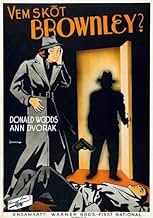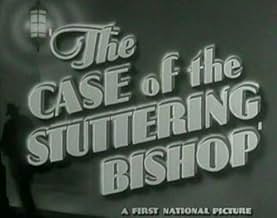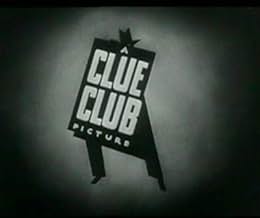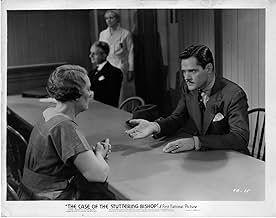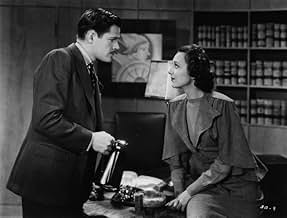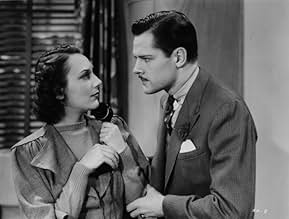VALUTAZIONE IMDb
6,2/10
613
LA TUA VALUTAZIONE
Aggiungi una trama nella tua linguaAn improbable stuttering bishop from Australia asks for Perry Mason's help in proving the identity of the legitimate heir to a millionaire.An improbable stuttering bishop from Australia asks for Perry Mason's help in proving the identity of the legitimate heir to a millionaire.An improbable stuttering bishop from Australia asks for Perry Mason's help in proving the identity of the legitimate heir to a millionaire.
- Regia
- Sceneggiatura
- Star
Helen MacKellar
- Stella Kenwood
- (as Helen McKellar)
Charles C. Wilson
- Hamilton Burger
- (as Charles Wilson)
Eddy Chandler
- Detective James Fleet
- (non citato nei titoli originali)
Recensioni in evidenza
We had two great evolutionary paths in the 30s. One was an amazing diversity of invention to settle some basic narrative devices that have since served us well as the basic vocabulary of cinema. The other, parallel path was the pulp detective novel, a master of which was Gardner.
The traditional, Holmes form is that you are linked to the detective. You discover what he does. Christie followed this form, but it is difficult to render in film. Gardner may be the first case — since common — of the novel adopting cinematic form. His formula does seem friendly to film: we see events that Mason does not, often before he gets seriously engaged. These events give us a false impression of what happened, so we as viewers start out with a deficit.
Then we have the detection; Mason and company are detectives in act two. The third act is always a courtroom, which is why our detective has to be a lawyer. Courtroom conventions have their own evolution in film, and this instance is limited to what in Christie's stories has to be a contrived assembly of the suspects.
This format allows for more complicated mysteries than were usual in film. My own preference for 30's detection is Philo Vance because the formula was not so strict. But this is a good one in terms of allowing complexity and surprise. We have that here in this solid instance.
One of the decisions in defining the characters is how intimate to make the relationship between alpha male Mason and his pretty and competent secretary. Why this matters has to do, as Mason would say, with motive. We like the guy. He is smart, as smart as other detectives, but why he does what he does
In some renderings of the Mason format, he just likes to win. He has his own Lestrade who he likes humiliating. Justice is incidental, and truth merely a tactic. He just like to strut.
In other renderings, he does what he does because he loves his team, his closest friend Drake and his lover Della. Both are profoundly loyal and true. He struts for her and we imagine passion after the obligatory Italian restaurant scene.
Here, a delicate balance between the two is maintained.
The traditional, Holmes form is that you are linked to the detective. You discover what he does. Christie followed this form, but it is difficult to render in film. Gardner may be the first case — since common — of the novel adopting cinematic form. His formula does seem friendly to film: we see events that Mason does not, often before he gets seriously engaged. These events give us a false impression of what happened, so we as viewers start out with a deficit.
Then we have the detection; Mason and company are detectives in act two. The third act is always a courtroom, which is why our detective has to be a lawyer. Courtroom conventions have their own evolution in film, and this instance is limited to what in Christie's stories has to be a contrived assembly of the suspects.
This format allows for more complicated mysteries than were usual in film. My own preference for 30's detection is Philo Vance because the formula was not so strict. But this is a good one in terms of allowing complexity and surprise. We have that here in this solid instance.
One of the decisions in defining the characters is how intimate to make the relationship between alpha male Mason and his pretty and competent secretary. Why this matters has to do, as Mason would say, with motive. We like the guy. He is smart, as smart as other detectives, but why he does what he does
In some renderings of the Mason format, he just likes to win. He has his own Lestrade who he likes humiliating. Justice is incidental, and truth merely a tactic. He just like to strut.
In other renderings, he does what he does because he loves his team, his closest friend Drake and his lover Della. Both are profoundly loyal and true. He struts for her and we imagine passion after the obligatory Italian restaurant scene.
Here, a delicate balance between the two is maintained.
Donald Woods and Ann Dvorak were fine as Perry Mason and his secretary, Della Street, but it took me a while to get used to not seeing Raymond Burr in the Mason role. The complicated plot involves two women named Janice who claim to be the heir to the fortune of Douglas Wood, and an Australian bishop who asks Mason to see Mira McKinney, who can prove which one is the real one. But Wood is killed going to the rendezvous with McKinney, who is charged with murder. In customary Perry Mason style, there is a final courtroom scene (in this case only a hearing) where Mason flushes out the killer and the phony Janice. I enjoyed trying to follow the plot and the comedy that was prevalent. Tom Kennedy suddenly remembers an important item when he hears the name "Sampson," because it involves a ship called "Delilah." Woods always asking Dvorak to remind him to give her a raise when she gets a good idea (a running gag). Even the bishop, who explains he stutters only when under some emotional stress, provides some comedy at the end. He sheepishly stammers "g-g-goodness g-g-gracious" when three of the principal women kiss him goodbye.
Donald Woods stars as Perry Mason in "The Case of the Stuttering Bishop," a 1937 film that also stars Ann Dvorak as a lively Della Street. Frank Faylen is also on hand to pep things up a bit. Both of them are needed, because Donald Woods isn't terribly exciting. Of the men who played Perry Mason in the films, he is perhaps the closest rendering to the actual character. But the book Perry Mason was just that - for books - and it would take Gardner himself to not only choose Raymond Burr (the original Perry Mason was supposed to be Fred MacMurray until Gardner saw Mason at an audition for Hamilton Burger) but oversee the scripts to make the translation to the moving image.
The story concerns a mysterious bishop who asks Perry to help clear a woman accused of manslaughter many years earlier. From there, the story gets into mistaken identity - is a woman posing as an heiress or isn't she - and the solving of a murder. It's a very complicated plot, so pay attention. And Paul Drake is old. If you can sort it all out, you'll find it interesting. There's a little comedy to be had, which is helpful.
I like watching the Perry Mason movies, if only to see the different interpretations of the various roles and the emphasis put into the stories, but in the end, it's best to forget who these characters are supposed to be - because after watching the TV show for years, none of them are. So don't expect much in that department, and you won't be disappointed.
The story concerns a mysterious bishop who asks Perry to help clear a woman accused of manslaughter many years earlier. From there, the story gets into mistaken identity - is a woman posing as an heiress or isn't she - and the solving of a murder. It's a very complicated plot, so pay attention. And Paul Drake is old. If you can sort it all out, you'll find it interesting. There's a little comedy to be had, which is helpful.
I like watching the Perry Mason movies, if only to see the different interpretations of the various roles and the emphasis put into the stories, but in the end, it's best to forget who these characters are supposed to be - because after watching the TV show for years, none of them are. So don't expect much in that department, and you won't be disappointed.
Maybe you can keep up with the plot convolutions better than I could. Finally I lost track of the yellow or pink or white raincoats and threw in the towel. Anyway, it's a mildly entertaining Mason entry, at best. As a matter of fact, it looks to me like Warner Bros. had lost interest in the series—(for example, compare the sparse production values here with the richly produced The Case of the Curious Bride {1935}). This was the last installment and features a boyish Donald Woods as the legal wizard and sleuth. Frankly, in my book, he lacks the forceful presence required to bring off the role in authoritative fashion, and was, perhaps, a last minute replacement for the more familiar Warren William. Ironically, it's this installment that more closely resembles the TV show with its first-part dramatic setup and second-part courtroom pyrotechnics. Too bad the exotic Ann Dvorak is largely wasted as a recessive Della Street— with her distinctive looks and lively personality, she should have been one of the suspects. All in all, the 70 minutes is for hardcore fans of the series and for fans of the perennially addled Tom Kennedy as the aptly named "Magooney".
Most of Edward McWade's roles were uncredited, but he certainly paid his dues in film-making; he had been making movies since 1919. Here he plays the stuttering bishop, who shows up at the office of Perry Mason (Donald Woods this time... Warren William had been playing Perry Mason for most of the 1930s.) with a case, then disappears. He makes accusations against the local rich man, Renald Brownley, played by Douglas Wood. Anne Dvorak and Joseph Crehan in supporting roles, as Mason confronts Brownley and tries to sort out the clues and what's going on. People start turning up dead, people are fighting, and then we're in the courtroom, like any good episode of Perry Mason. There are some comical moments, mostly between Mason and Della Street, and the names are a little confusing, with a Della, a Stella, TWO girls named Janice, and even an Ida. It's solid enough, with the usual court-room drama and outbursts. Directed by William Clemens, who had also directed many of the Nancy Drew and The Falcon films.
Lo sapevi?
- QuizAuthor Erle Stanley Gardner objected so vehemently to what he felt was the miscasting of Ricardo Cortez as Mason, that Warners replaced him with Donald Woods.
- BlooperNear the end, when Mason and his crew are having lunch during a court recess, Della drops her fork on her plate and reaches out across the table to break off some bread (after giving Mason the inadvertent hunch about Stella Kenwood). When the camera cuts back to Mason, Della has fork in hand again, but not the bread.
- Citazioni
Perry Mason: [to Della] Bishops don't often need lawyers. Show him in.
- ConnessioniFeatured in Il grande sonno (1946)
- Colonne sonoreWhen Irish Eyes Are Smiling
(1912) (uncredited)
Music by Ernest Ball
Lyrics by Chauncey Olcott and George Graff
Sung a cappella with a phony Irish brogue by Donald Woods
I più visti
Accedi per valutare e creare un elenco di titoli salvati per ottenere consigli personalizzati
Dettagli
- Data di uscita
- Paese di origine
- Lingua
- Celebre anche come
- The Case of the Stuttering Bishop
- Luoghi delle riprese
- Azienda produttrice
- Vedi altri crediti dell’azienda su IMDbPro
- Tempo di esecuzione1 ora 10 minuti
- Colore
- Mix di suoni
- Proporzioni
- 1.37 : 1
Contribuisci a questa pagina
Suggerisci una modifica o aggiungi i contenuti mancanti

Divario superiore
By what name was La vittima sommersa (1937) officially released in India in English?
Rispondi
